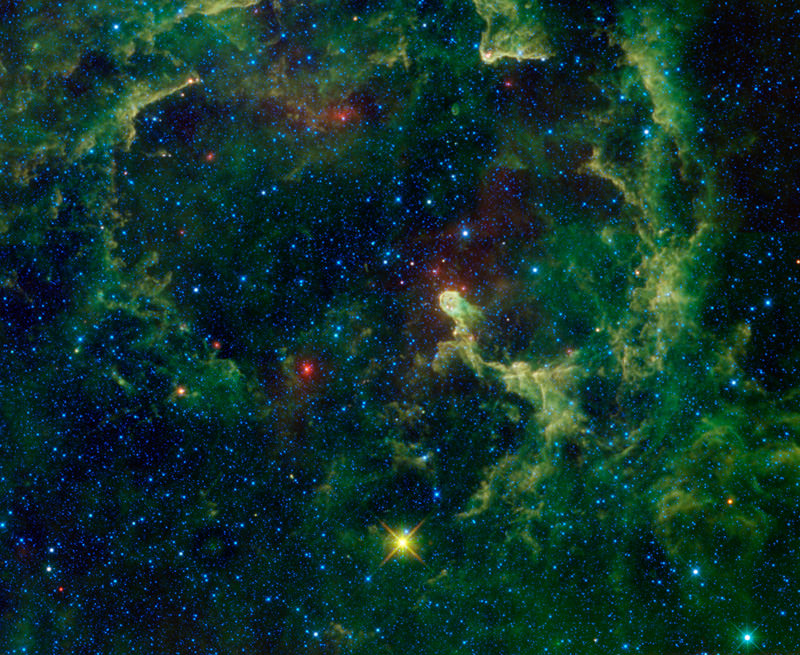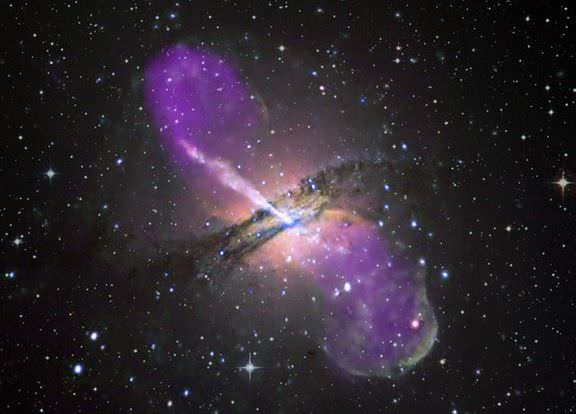The Cosmos
Stars, galaxies, nebulae, and cosmology
Also fundamental physics with possible astronomical or cosmological implications
Tutorials:
Big Bang
Inflation
The Cosmic Microwave Background
The Cosmic Dark Ages
Dark Matter
Dark Energy - For a more technical discussion go here.
Ask the Experts: What are dark matter and dark energy, and how are they affecting the universe? Measuring Stellar & Galactic Distances (difficult!)
Supernovas
Supernovas & Pulsars
Black Holes
Pulsars
Cosmology: the Observable Universe (moderately technical)
Cosmology (very difficult!)
Jun 12, 2011
 "This beautiful image, taken by NASA's Wide-Field Infrared Explorer (WISE) shows a vast ring of interstellar dust and gas being forced outwards by the wind and radiation from a massive star."
"This beautiful image, taken by NASA's Wide-Field Infrared Explorer (WISE) shows a vast ring of interstellar dust and gas being forced outwards by the wind and radiation from a massive star."
Jun 12, 2011
 "Cosmic rays are really sub-atomic particles, being mainly protons (hydrogen nuclei) and occasionally helium or heavier atomic nuclei and very occasionally electrons. Cosmic ray particles are very energetic as a result of them having a substantial velocity and hence a substantial momentum."
"Cosmic rays are really sub-atomic particles, being mainly protons (hydrogen nuclei) and occasionally helium or heavier atomic nuclei and very occasionally electrons. Cosmic ray particles are very energetic as a result of them having a substantial velocity and hence a substantial momentum."
Jun 11, 2011
 "The galaxy Markarian 739 has not one, but two ginormous black holes in its core."
"The galaxy Markarian 739 has not one, but two ginormous black holes in its core."
Jun 11, 2011
"Does our universe have mirror symmetry? That is the question physicist Michael Longo asked. The answer could perhaps be found by studying the rotation directions of spiral galaxies."
Jun 11, 2011
 "Back in 2006, astronomers used the Hubble Space Telescope to watch vast numbers of stars in the Milky Way's central bulge to look for gravitational lensing by extrasolar planets. The observations revealed 16 Jupiter-sized planetary candidates and also, as a byproduct, identified 42 oddly bright blue stars within the bulge."
"Back in 2006, astronomers used the Hubble Space Telescope to watch vast numbers of stars in the Milky Way's central bulge to look for gravitational lensing by extrasolar planets. The observations revealed 16 Jupiter-sized planetary candidates and also, as a byproduct, identified 42 oddly bright blue stars within the bulge."
Jun 10, 2011
 Interesting things are happening in the vicinity of the SN 1987a explosion.
Interesting things are happening in the vicinity of the SN 1987a explosion.
Jun 10, 2011
"Doomed Tevatron denied chance to go out with a bang as new particle is declared a false alarm"
Jun 8, 2011
 It's not a planetary nebula that surrounds this star -- at least, not yet.
It's not a planetary nebula that surrounds this star -- at least, not yet.
Jun 8, 2011
 "Although they only make up about one percent of the interstellar medium, giant molecular clouds are a rather formidable thing. These dense masses of gas can reach tens of parsecs in diameter and we know them as star forming regions."
"Although they only make up about one percent of the interstellar medium, giant molecular clouds are a rather formidable thing. These dense masses of gas can reach tens of parsecs in diameter and we know them as star forming regions."

 "Mechanism driving stellar explosions is a mystery"
"Mechanism driving stellar explosions is a mystery"